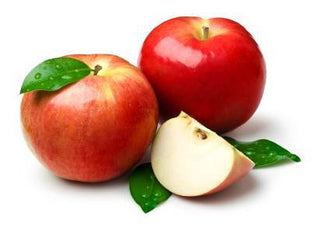(Malus domestica)
If watermelon is associated with summer then apples are synonymous with fall. This crisp, white-fleshed fruit comes in many sizes with a red, yellow or green skin. Depending on the variety, the taste of an apple can range from sweet to tart.
The apple tree originated in Eastern Europe and Southwestern Asia. Since then, apples have been cultivated throughout most regions of the world. In the 1600s, apples were brought to North America by colonists. It is believed that the first apple orchard was located near Boston in 1625. Apples traveled to New England with the Pilgrims, while Johnny “Appleseed” Chapman introduced the trees to the rest of the country. Today, the majority of apples in the United States are grown in Washington State. Over the centuries, many hybrids and cultivars have been developed, giving us the 7,000 varieties in the market today.
Nutrition Facts
A medium sized apple contains about 100 calories. While this fruit is sweet, an apple is an excellent source of fiber, providing 4 grams of both soluble (cellulose) and insoluble (pectin). Due to is high fiber content, the glycemic load of an apple is low compared to other sweet fruits like grapes. The majority of an apple’s fiber content can be found in the skin. Apples also contain a good source of vitamin C and potassium. Whole apples are a better choice than apple juice. Juicing concentrates the sugars and reduces the phytonutrient and fiber content from the fruit.
Apples contain a number of phytonutrients including quercetin, catechin, phloridzin and chlorogenic acid that have antioxidant and anti-inflammatory properties. These flavonoids are concentrated in the skin of the apple and increase as the fruit ripens.
Selection & Storage
A wide variety of apples are available year round. However, in the Northern Hemisphere, the best time to purchase apples is between late summer and early winter. While selecting, look for firm, rich-colored apples. The skin of the apple should be smooth and shiny.
Apples last longer than most fruits so they do not need to be stored in a specific way. For longer preservation, store apples in the refrigerator. Like all fruits, it is important to not wash apples until they are ready to be enjoyed. For cut apples that are stored in the refrigerator, extend the shelf-life by adding freshly-squeezed lemon juice. The vitamin C in the lemon juice will prevent the sliced apples from oxidizing and turning brown.
Health Issues
Apples are among the 12 foods that have high pesticide use, therefore, try to purchase organically-grown apples. Additionally, apples are often treated with wax to protect them during shipping and storage including beeswax, carnauba (carnauba palm tree) or shellac (from the lac beetle). Ask your grocer about the type of wax that is used as these are preferable to petroleum based waxes which contain solvent residues or wood resins.
Recipes
Apples can be eaten raw, baked or even turned into apple sauce. For a tasty, yet healthy salad, check out our very own recipe for Curry Chicken Salad. This salad combines chicken with green apples and another fall favorite, dried cranberries.
Fun Facts
The apple is a member of the rose family. An apple’s volume is about 25% of air making it float if placed in water. During the Jewish New Year, Rosh Hashanah, apples are eaten with honey to symbolize a sweet, New Year.

